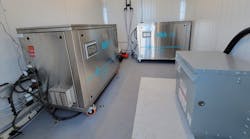What it is:
- Cadmium is a metal that forms salts in +2 oxidation state.
- It is primarily used for metal plating and coating operations in transportation equipment, machinery and baking elements, pigments, plastics, batteries, electronic components and nuclear reactors.
- It has a melting point of 320.9° C and a boiling point of 765° C.
- Its physical state is characterized as a soft white solid that is soluble in dilute nitric and concentrated sulfuric acids.
Occurrence:
- Cadmium is found in natural deposits containing other elements and is commonly associated with zinc because of their similar chemical characteristics.
- Food is the predominant source of ingestion exposure. According to the World Health Organization (WHO), the daily oral intake ranges from 10-35 µg.
- Smoking is a significant source of cadmium exposure. A cigarette contains about 1.7 µg of cadmium and about 10 percent of that is inhaled.
- Cadmium can sometimes be found in drinking water through corrosion of galvanized pipes or solders because it is associated with the zinc coating.
- It also finds its way into drinking water through waste discharges from several industries and the erosion of natural deposits. There are effluent guideline requirements for cadmium users.
Health effects:
- There is some evidence that cadmium is carcinogenic by inhalation, but none from oral exposure. It has been classified in the “probably carcinogenic to humans” category.
- The kidney is the main target organ for cadmium toxicity. Cadmium accumulates in the kidney with a half-life of 10-35 years and is slowly eliminated in urine.
- Short-term exposure to higher doses of cadmium could result in nausea, diarrhea, muscle cramps, liver injury and vomiting.
In the news:
- A review by the Tennessee Valley Authority (TVA) Office of Inspector General found groundwater contamination from coal ash at several TVA fossil power plant sites. Levels of toxic substances found at the Gallatin plant site in Sumner County and at the Cumberland site, 50 miles northwest of Nashville, are high enough that they could create a health hazard. Beryllium, cadmium and nickel levels are above drinking water standards at Gallatin, as are arsenic, selenium and vanadium at Cumberland.
Water treatment:
- There are several treatment methods that reduce cadmium below its MCL. These include: Coagulation and filtration, ion exchange, lime softening and reverse osmosis.
Regulation:
- A maximum contaminant level goal (MCLG) of 0.005 mg/L or 5 ppb. EPA sets this level of protection based on the best science available to prevent adverse effects on health with a margin of safety. A maximum contaminant level (MCL) of 0.005 mg/L or 5 ppb has been set for cadmium.
- The MCL and MCLG are equal in this case because analytical methods or treatment technology do not pose any limitation. EPA sets the MCLs as close to the health goals as possible, considering benefits, cost and the ability of public water systems to detect and remove contaminants using suitable treatment technologies.
Sources: Environmental Protection Agency, World Health Organization and freedrinkingwater.com.
Water Technology would like to thank Dr. Joseph Cotruvo for reviewing this information and providing additional content. Dr. Cotruvo is president of Joseph Cotruvo and Associates, LLC, Water, Environment and Public Health Consultants. He is a former director of the U.S. EPA Drinking Water Standards Division.


